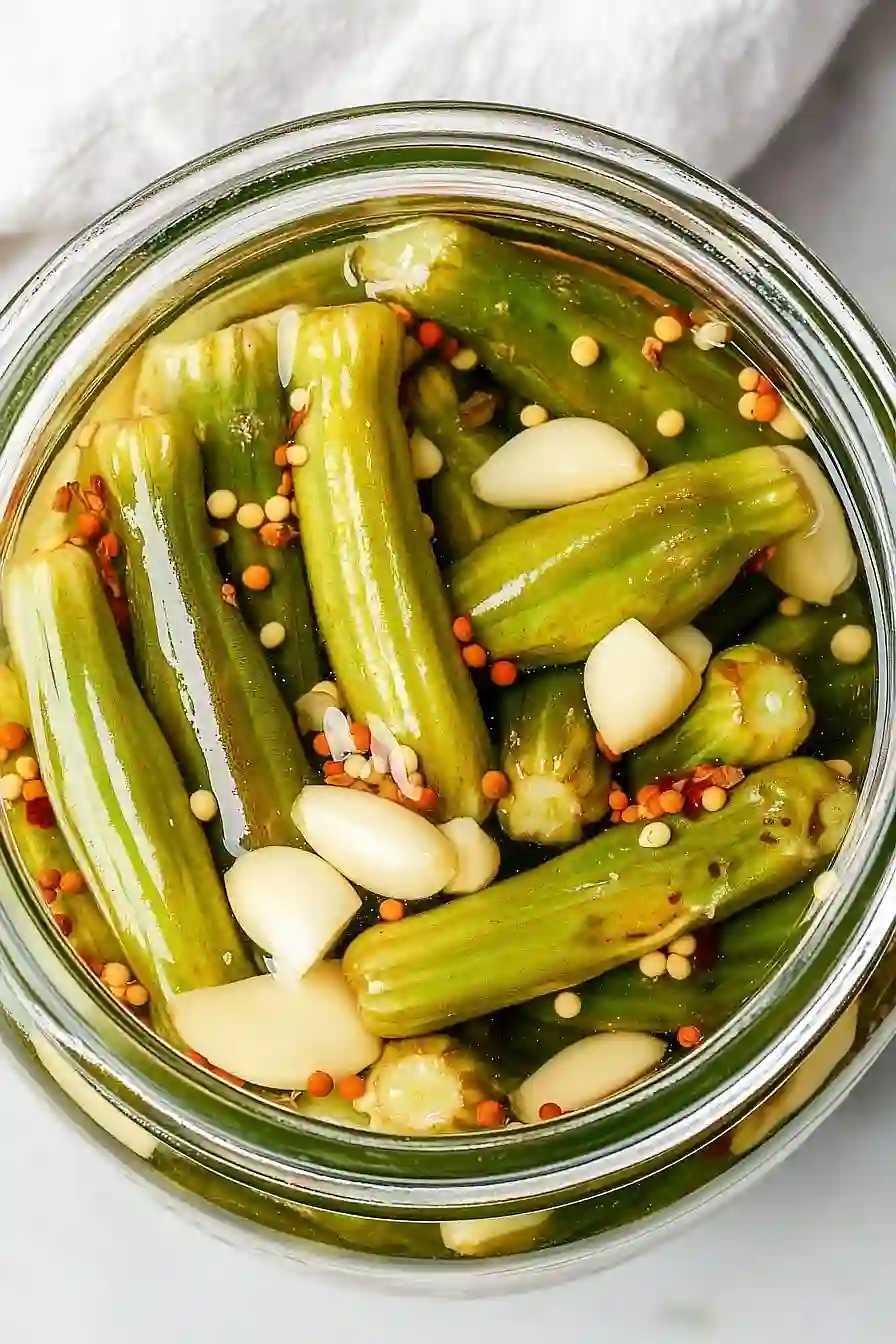I never understood the appeal of pickled okra until my neighbor brought a jar to our summer block party last year. Growing up, the only okra I knew was the slimy, boiled kind that made an occasional appearance at family dinners. Nobody in my house dared to experiment with it beyond that.
Turns out, pickling okra is actually one of the best ways to enjoy this Southern vegetable. The vinegar brine cuts through that trademark sliminess, and the result is a crunchy, tangy snack that’s become a staple in my fridge. Even my kids, who normally run at the sight of anything green, grab these by the handful.

Why You’ll Love This Pickled Okra
- No cooking required – This recipe only needs basic mixing and jarring – no stove or special equipment needed beyond your jars.
- Make-ahead friendly – You can prepare these pickles when okra is in season and enjoy them for months to come – they only get better with time.
- Customizable heat level – Adjust the crushed red pepper to make your pickles as mild or spicy as you like – the recipe is totally flexible.
- Simple ingredients – Everything you need is easy to find at regular grocery stores, using basic pickling ingredients you might already have in your pantry.
- Great for snacking – These tangy pickles make a perfect low-calorie snack, appetizer, or addition to cheese boards and sandwich plates.
What Kind of Okra Should I Use?
For pickling, you’ll want to look for young, fresh okra pods that are bright green and between 2-4 inches long. Smaller pods are typically more tender and will fit better in your pickling jars, while larger ones can be tough and woody. When shopping, gently squeeze the pods – they should be firm but not hard, and avoid any that feel soft or show brown spots. Fresh okra is usually available in summer months at farmers markets and grocery stores, but if you’re buying from a supermarket, check that the pods aren’t slimy or discolored. For the best pickles, try to use your okra within a day or two of purchasing, as it doesn’t stay fresh for very long.

Options for Substitutions
While pickling is pretty specific, there are still some ways you can switch things up in this recipe:
- Vinegar: You can use different types of vinegar like apple cider vinegar, white wine vinegar, or rice vinegar instead of regular white vinegar. Each will give a slightly different flavor profile, but keep the same amount.
- Fresh okra: This is the star ingredient that can’t really be substituted – you need fresh, firm okra for proper pickling. Just make sure to pick smaller pods as they’re more tender.
- Spices: Feel free to play around with the spice mix! You can swap coriander for cumin, add mustard seeds, or use black pepper instead of peppercorns. Not a fan of heat? You can reduce or skip the crushed red pepper.
- Garlic: If you’re not big on garlic, you can reduce the amount or replace some with sliced onions or shallots. You could also add fresh dill or other herbs.
- Sugar: You can use honey instead of sugar (use about 1.5 tablespoons), but don’t skip the sweetener entirely as it helps balance the flavors. The salt is necessary for proper pickling and can’t be reduced.
Watch Out for These Mistakes While Pickling
The biggest challenge when pickling okra is ending up with slimy pods – to prevent this, make sure to choose fresh, young okra pods that are no longer than 3 inches and avoid washing them until right before use. Another common mistake is not properly sterilizing your jars, which can lead to spoilage and unsafe pickles – always boil your jars and lids for at least 10 minutes before filling them. The brine temperature is crucial too – adding hot brine to room temperature okra helps maintain crispness, while cold brine can make your pickles soft and mushy. For the best flavor development, resist the urge to eat your pickles too soon – letting them cure for at least 2 weeks allows the spices to fully infuse into the okra and creates that perfect tangy crunch.

What to Serve With Pickled Okra?
Pickled okra makes an awesome addition to so many Southern-style meals and snacks! These tangy pods are perfect for adding to a cheese and charcuterie board alongside some sharp cheddar, smoked meats, and crusty bread. They also make a great garnish for Bloody Marys or martinis if you’re hosting brunch or happy hour. For a casual lunch spread, try serving them alongside sandwiches, burgers, or pulled pork – the acidic crunch provides a nice contrast to rich, meaty dishes. You can even chop them up and add them to potato salad or macaroni salad for an extra punch of flavor.
Storage Instructions
Keep: Once your pickled okra is ready, store the jars in a cool, dark place like your pantry. Unopened jars will stay good for up to 1 year – just make sure to check that the seal remains intact. After opening, keep the jar in the fridge.
Refrigerate: Once you’ve opened a jar of your pickled okra, pop it in the fridge. The vinegar brine helps these pickles stay crunchy and flavorful for up to 2 months. Just make sure the okra stays submerged in the brine for the best results.
Tips: For the best pickle experience, let your okra sit in the brine for at least 48 hours before eating – this gives the flavors time to develop. The longer they sit, the more intense the flavor will become. Remember to always use clean utensils when reaching into the jar to avoid contamination.
| Preparation Time | 15-20 minutes |
| Cooking Time | 10-15 minutes |
| Total Time | 24 hours 25-35 minutes |
| Level of Difficulty | Easy |
Estimated Nutrition
Estimated nutrition for the whole recipe (without optional ingredients):
- Calories: 200-250
- Protein: 5-10 g
- Fat: 0-2 g
- Carbohydrates: 50-60 g
Ingredients
For the vegetables:
- 1/4 lb garlic cloves (peeled and halved)
- 1/2 lb fresh okra (trimmed)
For the pickling solution:
- 2 tbsp sugar
- 2 tsp coriander seeds (lightly crushed for more flavor)
- 1 tsp peppercorns (black or mixed peppercorns)
- 1 tsp fennel seeds
- 2 cups vinegar (white or apple cider vinegar works great)
- 2 tbsp salt (kosher or pickling salt preferred)
- 2 cups water
- 2 tsp crushed red pepper (adjust to your spice preference)
Step 1: Prepare the Jar with Spices
Start by placing the coriander seeds, pepper flakes, peppercorns, and fennel seeds at the bottom of a clean quart jar.
This will be the base layer of flavors for your pickling solution.
Step 2: Layer the Vegetables
Next, carefully layer the okra and garlic cloves on top of the spices in the jar.
Arrange them compactly to maximize space and ensure even pickling.
Step 3: Make the Pickling Solution
In a saucepan, combine the vinegar, water, salt, and sugar.
Bring the mixture to a boil, stirring until all the salt and sugar have completely dissolved.
This creates the brine that will preserve and flavor the okra.
Step 4: Cool and Add the Brine
Allow the hot pickling solution to cool to room temperature.
Once cooled, pour it into the quart jar over the layered okra and garlic, making sure everything is submerged under the brine.
Step 5: Refrigerate and Let Pickle
Seal the jar with a lid and place it in the refrigerator.
Allow the okra to pickle by letting it sit for at least 24 hours before enjoying.
This resting time ensures that the flavors fully develop and permeate the okra.

